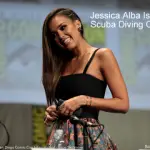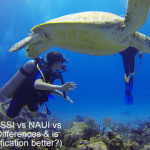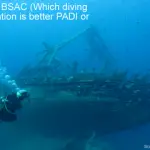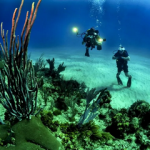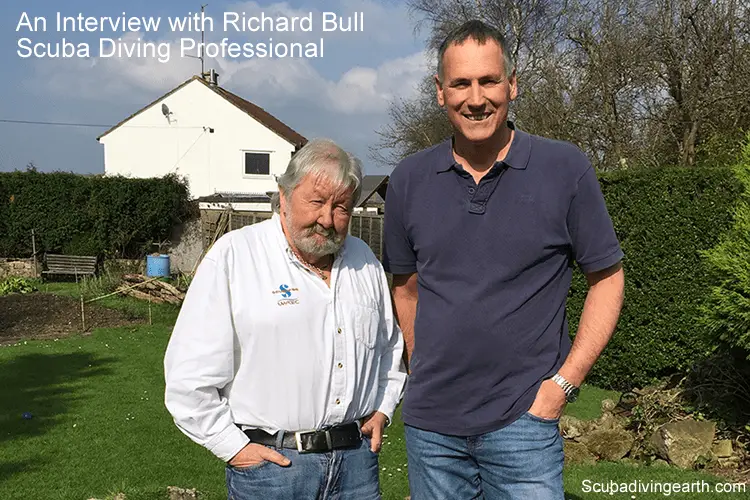
I hope you are inspired by this interview with Richard Bull about how he became a professional scuba diver
I had the privilege to meet professional scuba diver Richard Bull for an interview. The interview recounts his life and his stories. These stories include a number of very famous celebrity scuba divers.
He began his career as a base-player in a famous rock band. But discover how his passion of scuba diving led to him work with the prestigious BBC series Blue Planet I and Blue Planet II.
If you’ve not seen either series before, here’s a short 5 minute clip of Blue Plant II, narrated by Sir David Attenborough:
This world-exclusive introduction to the show is narrated by series presenter Sir David Attenborough and set to an exclusive track developed by Hans Zimmer and Radiohead. The prequel features an array of some of the most awe-inspiring shots and highlights from the new series, as well as several exclusive scenes that will not feature in any of the seven episodes which are set for UK broadcast on BBC One later this year.
The best way to do more diving is to book yourself on a scuba diving liveaboard. You can check the latest and best deals on liveaboards using the following window:
Discover how he worked and scuba dived with the following famous people:
- Actor Charles Dance: His first involvement as a professional scuba diver with a film set.
- Broadcaster Sir David Attenborough: This part fascinated me, plus discover how it was Richard who certified Sir David Attenborough to scuba dive with BSAC.
- Astronaut Buzz Aldrin: The second man to walk on the moon. This part of Richard’s story should at least make you smile.
- Comedian Ruby Wax: He recounts a story where an encounter with a great white shark nearly went horribly wrong.
- Diving pioneer Phil Nuytten: The inventor of the Newtsuit for professional deep sea divers, which has been tested to 900 metres (2,953 feet).
- Deadly 60’s Steve Backshall: He recounts an amusing story about 16-18 whale sharks.
- Scuba diver and passionate environmentalist Philippe Cousteau: Filming Giant Humboldt Squid in strong currents at night…a recipe for disaster! Philippe is the grandson of the inventor of the aqua lung Jacques Cousteau.
You’ll also learn how every professional diver on the planet has rubbed shoulders with the television and film business. If you want to become a professional scuba diver, you may learn something from Richard’s story.
The interview is split into sections, but if you’d like to listen to the complete interview this can be found towards the end of the article. I hope you enjoy listening to Richard as much as I enjoyed interviewing him.
Where did Richard Bull’s professional scuba diver story begin?
A few highlights from this section of the interview.
Richard decided not to go to university, but instead he joined a rock band.
The band that Richard Bull had most success with was called The Kursaal Flyers. When he was in the Kursaal Flyers they had a top 10 hit ‘Little Does She Know‘. See YouTube video below. He’s the one playing guitar with the hat on.
Little Does She Know by Kursaal Flyers Words & music: Birch/Douglas/Shuttleworth. Published by Rock Music Company Ltd. Produced by Mike Batt for CBS (1976). Top Of The Pops 9th December 1976 with Brand X, Sudso and Gluggo washing powders! Available on ‘Double Or Quits’ (a 2-on-1 CD pairing of the Golden Mile and Five Live Kursaals! albums, Rev-Ola CRREV 293) and ‘Hit Records: The Best Of The Kursaal Flyers’ (On The Beach FOAMCD6)
He mostly played base guitar. But he’s also known for playing banjo too. He recounts playing his banjo on a KFC advert.
During this part of his professional career, scuba diving was his hobby like it is with most scuba divers.
At this stage in his life he moved to Oslo. Whilst the move to Norway was music related, it allowed him to go scuba diving every day. It was also where he got his first job in the diving industry. It was in Norway when he first became a professional scuba diver.
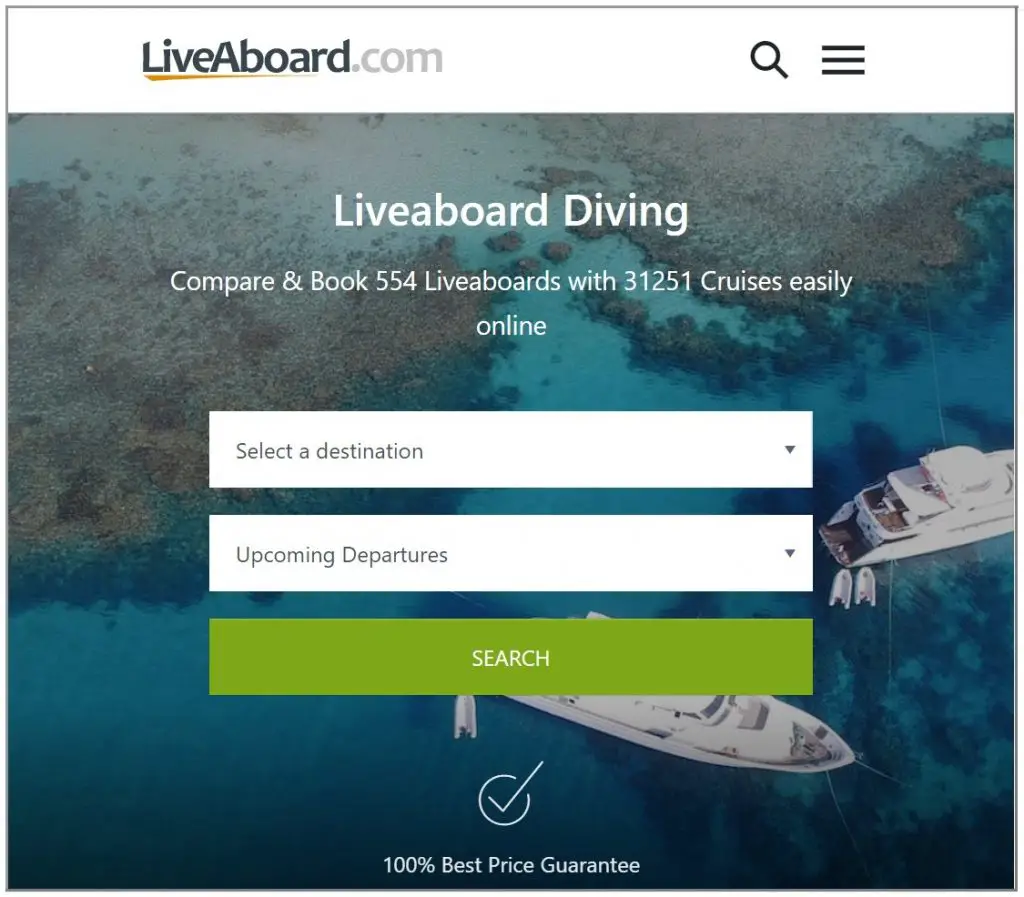
The perfect storm: When creativity met with his favourite hobby scuba diving
His move to become a professional scuba diver led him to be involved in his first big movie. This movie included Game of Thrones star Charles Dance, in 1988 First Borne.
Listen to the beginning of his story in this first short clip with Richard:
Richard Bull’s professional scuba diving business built around the potential for killing celebrities
Richard Bull has worked with many celebrities and worked with the team on Blue Planet. As a result he has dived all over the world helping filmmakers make underwater films.
He jokes about how his professional scuba diving company was in the business of “potentially killing celebrities“.
But fortunately for Richard (and the celebrities of course) he didn’t manage to kill any.
Richard Bull worked on both Blue Planet I and Blue Planet II. As most Blue Planet fans know, these were narrated by the wonderful scuba diver himself Sir David Attenborough.
Richard’s role in making films and documentaries like Blue Planet was as the scuba diving advisor. This role included taking care of the safety aspects of the underwater filming.
Program makers like the BBC, which includes underwater filming, are legally obliged to have professional scuba diving contractors like Richard work on each program.
This means that a registered HSE diving contractor from a recognised organisation must be involved. This is where Richard’s business came into the mix. It was his role to supervise the scuba diving when any underwater filming took place.
Having a professional scuba diving contractor involved with underwater film making is not just about safety. But is also about getting the film made. His professional role required him to have a good understanding of scuba diving in all conditions.
This included filming in strong currents, night time diving and also deep diving.
Having this knowledge was essential to understand what equipment would be right to make the film shoot work and be safe. It also required a good understanding of where to place everyone involved in each underwater shoot. His creative side helped with this element of being a professional scuba diver.
Underwater filming as a professional scuba diver: Introducing Richard’s cartoon-like dive plan sketches
One of the programs Richard helped film was for Blue Peter (One of my childhood favourites). This was filmed in the Farne Islands (My favourite cold water dive). If you’ve not been or dived the Farne Islands, please take a read about diving with seals.
In addition to working alongside underwater filmmakers, Richard also worked in the capacity as a professional dive trainer. He would work with the BBC on many occasions, but in particular with Sir David Attenborough (Both Richard’s and my childhood hero).
The BBC would send Sir David Attenborough to Richard. Before he went off diving for the BBC, Richard would give him a diver refresher in a swimming pool.
Working with Buzz Aldrin scuba diving in the Caribbean
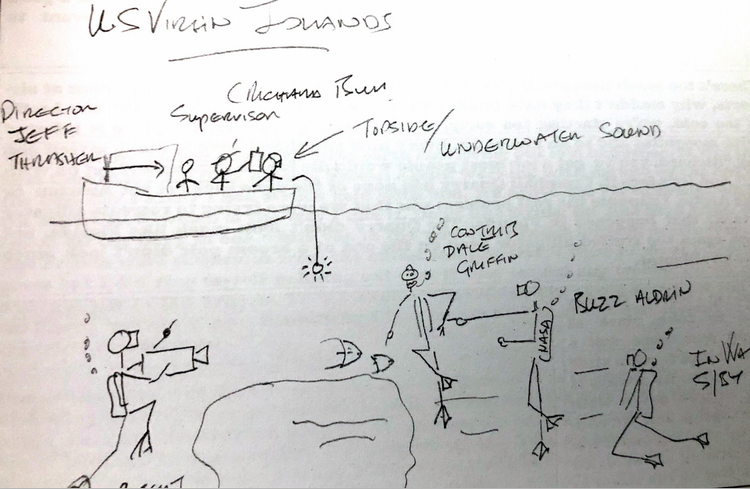
Richard just had to mention Buzz Aldrin. It really interested me when Richard explained how he’d worked with the second man to step foot on the moon Buzz Aldrin. It was in the Caribbean and he was working for a Canadian film-making company.
We laughed about one of Richard’s most memorable faux pas. This was after he had explained to Buzz Aldrin about how to use a diving helmet.
You’d think that explaining life support to an ex-astronaut shouldn’t be a problem. But the funny faux pas was when Richard said to Buzz “honestly Buzz, it’s not rocket science.’
Working with scuba diver Ruby Wax and Great White Sharks
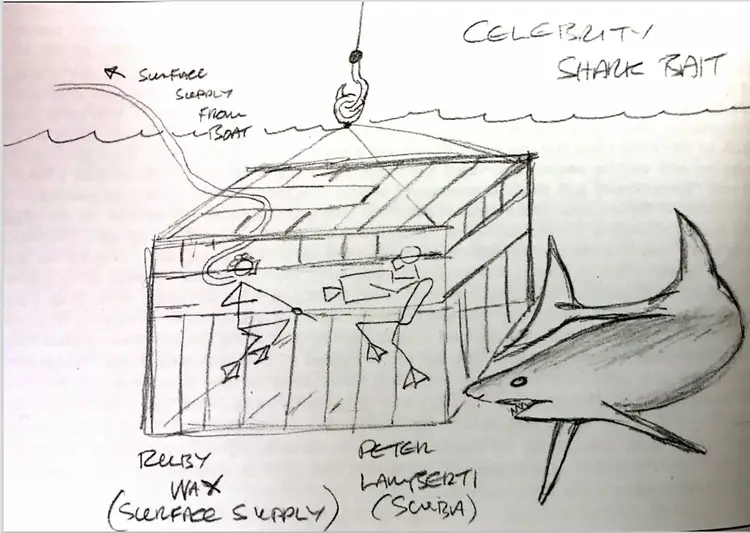
He went on to explain how he also worked with scuba diver Ruby Wax. This was on a film shoot in South Africa filming Great White Sharks.
Ruby Wax was in a shark cage in Shark Alley off from Dyer Island.
As an aside, you should read about where is the best place is to cage dive with sharks. If you live in or near to San Diego you’re in luck, as their is a great trip to Guadalupe Island.
In this interview snippet about Ruby Wax he introduces how he used cartoon-like sketches to plan the dives alongside the film making.
As he introduces the cartoon dive plan sketches, he mentions his involvement with Paul Rose on a series called Oceans. It was Paul Rose who encouraged Richard to put his dive sketches into a book. I have included a few of these in this article.
Here’s the sketch he did for the Ruby Wax shoot diving with Great White Sharks.

The book includes 100 of the best sketches from over 500 sketches. All these sketches were done during his professional diving career.
These really fun sketches cover off a really important side to any dive, which is planning the dive for safety. These amusing and cartoon like images made it more likely that the people involved with the filming were more likely to look at them.
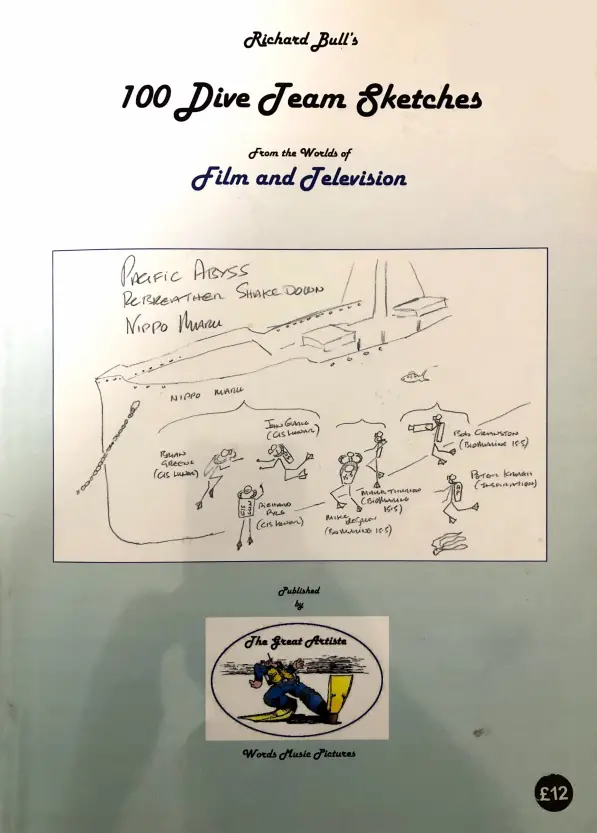
Dive supervising on HSE courses for underwater cameramen
Richard then became an HSE dive supervisor. This was to help newbie underwater cameramen get into the film business. No newcomer is permitted to get into the underwater filming business unless they have an Underwater HSE certification.
This means that all underwater camera men have to attend a course in underwater safety. Which is how Richard got involved. This is when he was invited along to the organisation running the underwater filming courses to provide his experience and knowledge of his work in the industry.
He also talks about his book ‘The Fat Boy Paints Wide Roads‘. The painting wide roads stems from his childhood when he was admonished for being different. From that moment on, Richard chose to be different and to be proud of his difference in the world.
What was Richard’s most dangerous situation as a professional scuba diver
When I asked Richard what his most dangerous situation had been when scuba diving, he rephrased the question to ‘the most potentially dangerous situation he was involved with.’
Richard was supervising the dive and not diving himself in the situation he describes. The incident happened when he was involved in filming out in the Pacific Ocean on the edge of the Mariana Trench (the deepest part of the ocean).
Professional dive supervisor for a 100+ metre (328+ feet) deep dive
The potentially dangerous situation involved an extremely deep dive to 100+ metres (328+ feet). The divers he supervised were on mixed gas re-breathers.
The potential danger from diving to these depths obviously related to the horrendous decompression time required. The added risk he had to contend with was the dive site was two days from the nearest recompression chamber.
A potentially dangerous diving situation did occur. But testament to Richard Bull’s professionalism and skill meant that the diver concerned came to no harm.
The problem didn’t occur at 100 metres, but occurred at 9 metres (30 feet).
It happened to American professional scuba diver Richard Pyles, who had a rebreather malfunction. What helped was that Richard Pyles is one of the greatest diving pioneers, which meant he kept calm in the situation. You may also be interested to read this article about Pyles in Science Magazine.
Richard Bull had made sure there were sufficient open circuit dive tanks for Richard Pyles to use in place of his rebreather.
Another scuba diving pioneer and deep-ocean explorer Phil Nuytten
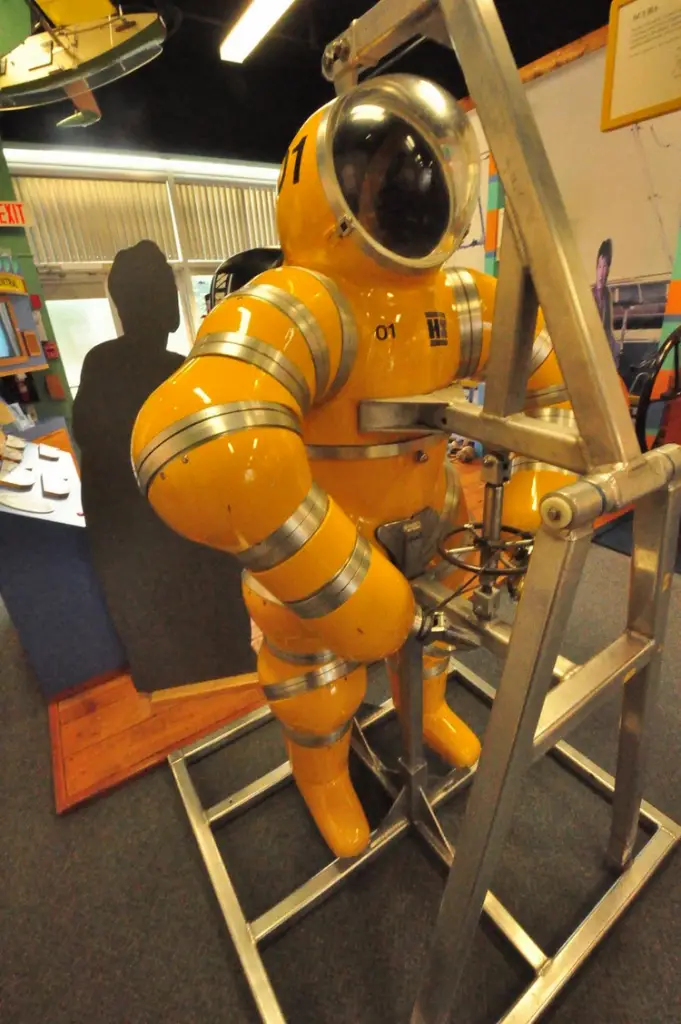
Also on the dive to 100 metres in the Pacific was another scuba diver admired by Richard Bull. A Canadian entrepreneur, a deep ocean explorer and scientist Phil Nuytten.
Phil Nuytten is known for inventing the Newtsuit, which is an atmospheric diving suit. The Newtsuit is used by professional scuba divers on ocean drilling rigs, pipelines and salvage jobs. The Newtsuit has been tested to 900 metres (2,953 feet).
To discover more and to find out why they were filming at 100 metres, here’s the audio clip on this section of the interview:
This section of the interview continues and looks at In-Water Recompression.
In-water recompression – emergency treatment for decompression sickness required when the nearest recompression chamber is two days away
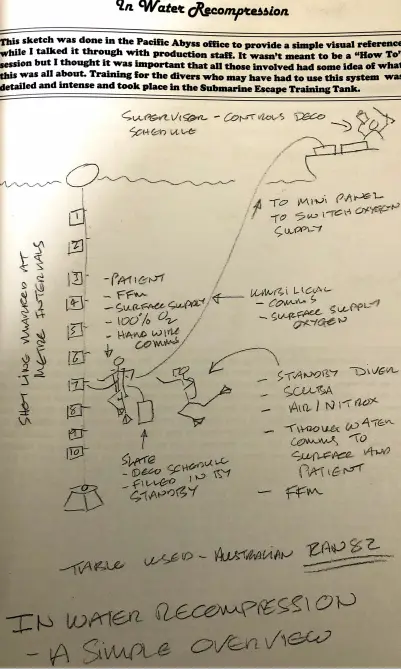
With the nearest recompression chamber two days away, what are the options for recompression? This question is even more important when the dive being planned is to 100 metres (328 feet).
As already explained, the major problem Richard Bull had was when Richard Pyles’ rebreather malfunctioned at 9 metres (30 feet). It was at this point when Pyles still had two and half hours of decompression left to do! That’s amazing when you consider he only spent about 15 minutes at 100 metres.
As it happens, Richard Bull had open system dive tanks on hand with the right gas mix to allow Richard Pyles to finish off his decompression stop at 9 metres. This avoided having to resort to using Richard Bull’s in-water recompression system.
What is in-water recompression?
In-water recompression (IWR) is used for the emergency treatment of decompression sickness (DCS) by sending the diver back underwater instead of into a recompression chamber. In-water recompression, which is also known as underwater oxygen treatment, allows the gas bubbles in the tissues to settle.
Richard Bull explains how he wrote articles about in-water recompression. One such article was for a Dive magazine. The article was about how he set up the system for the BBC. He explained how he was able to have his in-water recompression system approved by the BBC.
He also explains about The SPUMs Journal (South Pacific Underwater Medical Society). The SPUMS do in-water recompression all of the time. Also, the Australians have a table for in-water recompression too, which is called the Australian RAN82 Table. He used these Australian tables for his in-water recompression.
Richard points out that in-water recompression is a ‘far cry from bunging someone back in the water.’
But in a sombre tone, Richard explains how when diving to 100 metres, there is a potential for death.
For more details about Richard Bull’s in-water recompression, please listen to the next interview clip:
The funniest or most amusing situation in Richard’s professional underwater filming career
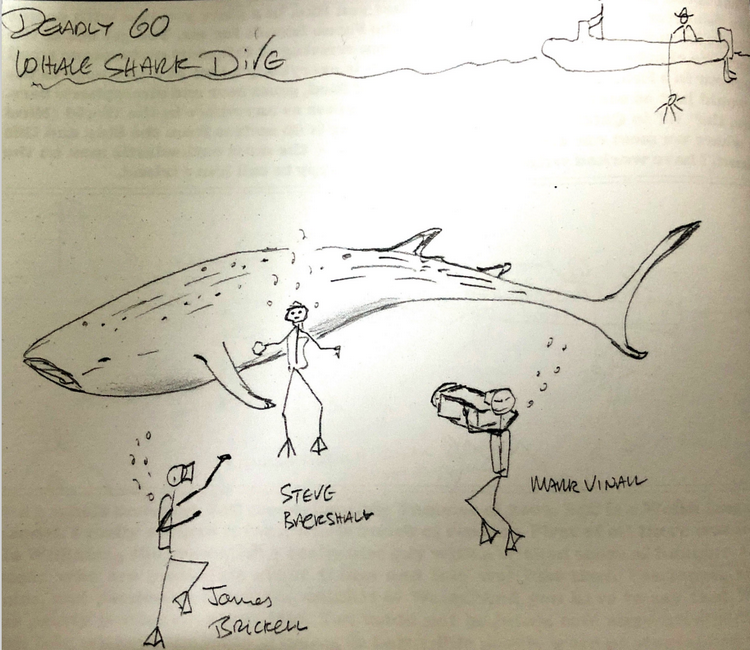
Richard wouldn’t divulge about any celebrities that may had fallen in the water. But instead he went on to explain how he enjoyed working with all the people on the film sets. He recounts how on some of the film sets he spent most of his time in fits of laughter.
He goes on to talk about the Deadly 60. The Deadly 60 is when he spent time filming with excitable scuba diver Steve Backshall. Richard explains how Steve Backshall is an excellent scuba diver. He shares how he really enjoyed working with the Deadly 60 team.
They were filming Mantas in Mozambique for Deadly 60. He recalled how instead of filming the Mantas, they filmed Whale Sharks instead, as these had turned up unexpectedly.
This part of his story telling is very amusing. He talks about when 16-18 whale sharks turned up when filming in Tanzania, please listen to the next interview clip to find out more:
The most challenging or most difficult underwater filming in his professional scuba diving career
When I asked Richard about his most challenging or most difficult filming moment in his professional scuba diving career, he explained about filming Humboldt Squid.
The filming was for the Oceans Series. It was during this series when he met Philippe Cousteau (grand son of the late Jacques Cousteau and not to be confused with explorer Philippe Cousteau Sr. son of Jacques). He also worked with Paul Rose, an expert in polar exploration, diving and mountaineering.
What made the underwater filming more challenging was a combination of strong currents and diving at night. This combination of factors has the potential for disaster written all over it. But once more, this is testament to Richard’s skill of keeping his divers safe. As a result the filming went without incident.
To avoid the underwater cameramen from being washed away in the strong currents, Richard had them tied to strong rope. These were linked back to the boat.
Whilst the video below is not the Oceans footage, it is of Humboldt Squid at night. This film is with scuba diver Steve Backshall filming for Deadly 60 in the Sea of Cortez.
We take a dip and swim with the Humboldt squid.
For more on this part of the interview with Richard Bull, please listen to the clip below:
Professional scuba diver Richard Bull’s favourite dive
Richard found this question difficult, as he has dived in so many places around the world.
One place he did agree that he loves more than most is to dive in the Arctic. For Richard scuba diving is about the experience.
Which led on to explain how he loves to dive the Lofoten Island off the coast of Norway. Again the water temperatures are extremely cold, so a full-face dive mask is required to dive in such cold waters.
Richard describes how Lofoten is within the Arctic Circle, but the waters don’t freeze. This is due to the affects of the Gulf Stream.
He also makes reference to the Sea of Cortez as a favourite dive spot, which is off the coast of Mexico. Richard has dived many times in the Sea of Cortex, where there’s fantastic life…and it’s big.
For more on why he likes these places to dive, please listen to this next clip:
Great white shark cage incident in South Africa
When Richard was filming Great White Sharks in South Africa with Ruby Wax, he had an incident with one of the underwater cameramen. Fortunately, the underwater cameraman wasn’t harmed. But he was shaken by the experience.
The filming was from inside the shark cage to show the celebrities view point. Which in this case was scuba diver Ruby Wax. But the problem occurred when a smaller and younger Great White Shark appeared.
This shark was behaving like an eighteen year old in a pub. It was acting in an aggressive manner from the start. The major problems began when the shark made its way into the shark cage.
Fortunately at this stage Ruby Wax wasn’t in the cage. Richard feared the worst though, as the South African cameraman was still in the cage. He thought it would be the end of his career as a dive supervisor, if the shark had injured or worst still killed the cameraman.
The underwater cameraman was able to use his camera to keep the Great White Shark at bay and he was able to escape unharmed. Not the film footage with Ruby Wax, but an example of how cage diving with Great White Sharks can go horribly wrong.
A great white shark breaks through a diving cage near Guadalupe Island, Mexico. Video credit: Brian Ernst
To listen to Richard retell this part of his career, please listen to the next short clip:
Richard Bull certified Sir David Attenborough to scuba dive
Richard’s proud claim is he certified Sir David Attenborough to scuba dive. However, he quickly points out that he didn’t teach him to dive.
Attenborough had been diving for years without certification. But in the later years, as things became more prescriptive, the BBC insisted that he get himself certified. Richard’s not one for turning up an opportunity like this one, so did the honours.
At the time, Sir David Attenborough was a more than competent scuba diver. However, Attenborough was being refused on dive boats. This was due to him not having the required certification to scuba dive.
Richard also gave Sir David Attenborough scuba diving refreshers and he also taught him how to use a bubble helmet.
Co-founder of the European Association of Technical Diving (EATD), which became the IANTD (The International Association of Nitrox and Technical Divers)
Richard was one of the co-founders of the European Association of Technical Diving (EATD). Which became the International Association of Nitrox and Technical Divers (INTD)
He set EATD up with Kevin Gurr and Rob Palmer in 1992. But this was merged into the IANTD in the following year. The UK website is the IANTD UK.
His deepest dive: 134 metres with over some 7,000 dives under his belt
Richard Bull’s dived over 7,000 scuba dives and dived to 134 metres (440 feet).
Richard racked up many of his dives when he was a resort scuba diving instructor in Malta. In Malta he was doing two to three dives per day for six days a week for over two years. He also worked as a scuba diving instructor in Oslo doing hundreds of dives per year.
Although Richard occasionally dives now, his current passion is his boat. The boat he has is the sister boat of the one that Sir William Robert Patrick Knox-Johnston used to single handed circumnavigated the globe – non-stop.
Scuba diver qualifications including BSCA, PADI and NAUI
Richard has gained more qualifications than I’m sure any other scuba diver in the world. But his first dives began without any qualification.
He has a certification with many of the international scuba diving associations, which includes BSAC, PADI and Naui. You should read this article about the difference between PADI, SSI, NAUI and BSAC scuba diving certifications. The article includes a useful table of the differences between each one.
Professional scuba diver becomes managing director of ScubaPro UK
Richard owned a dive shop in Bristol for a number of years. His dive shop was Richards first links with the BBC. It was this shop that was the nearest to the BBC in Bristol. Whenever the BBC needed new scuba diving equipment, they’d go to his dive shop.
But he also became the Managing Director of Scubapro UK for a couple of years.
When I asked Richard about working for Scubapro, he explained that he did enjoy the job for the short while he was there. But he also explained how he didn’t like working in an office.
His job was helped by the fact that he loves Scubapro equipment. He describes Scubapro as ‘no nonsense proper diving equipment for no nonsense proper divers.’
It was Scubapro that approached Richard to become the MD of the UK arm of the diving equipment company.
To find out how he was approached to become the MD of Scubapro, please listen to the next clip of the Richard Bull interview. But also how he ended up having a deep and meaningful conversation with an insolvency practitioner:
Over 100 books on scuba diving and his work with Philippe Cousteau
Richard has over 100 books on scuba diving in his book library.
He doesn’t have a book recommendation for would-be scuba divers or professional scuba divers, but he does advise to be open minded and read everything you can on the subject.
He explains that it’s not the world according to BSAC, PADI or Naui, but instead listen to some of the scuba diving greats. For example, the chief diver on the Calypso Albert Falco who dived alongside Jacques Cousteau.
We both agreed that Jacques Cousteau was one of our scuba diving heroes. Richard didn’t get to meet the great man himself. But as already mentioned, he got to work closely with his grandson Philippe Cousteau on the Oceans Series. Whilst working with Philippe Cousteau, he got to read a hand written letter by Jacques Cousteau.
You may like to read about the top ten dives in the world by Jacques Cousteau. If you love hammerhead sharks, number 10 is a must-read.
The complete interview with professional scuba diver Richard Bull
If you would prefer to listen to the whole interview with Richard Bull, instead of each separate snippet, this can be done by clicking on the recording below:
I hope you enjoyed this interview with professional scuba diver Richard Bull
If you’ve been inspired by this interview with Richard Bull, please share your thoughts and comments below about what inspired you the most. I’d love to hear from you.
Good luck on your own journey to become a professional scuba diver. Please come back and share your successes and experiences.
If this article hasn’t answered all of your questions. If you have more questions either about snorkeling or scuba diving (or specifically about the interview with Richard Bull and his experience as a professional scuba diver), please also comment below with your questions.
Have fun and be safe!

